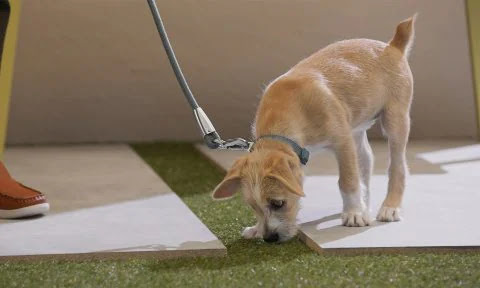Housebreaking is a top priority right after you bring home a new dog. If you're a pet owner, you know there are a few things you're on the hook for when it comes to potty training your puppy.
You need to be patient and diligent, and provide ample encouragement and prizes. Never resort to punishment; otherwise, the puppy will associate going to the bathroom in that area with unpleasant feelings, and the training process will take much longer than necessary.
If you want to successfully house-train your puppy, there are a few things to keep in mind.
1. Plan ahead for where you want the puppy to go when you let it outside. Many pet owners overlook this crucial phase, but once the puppy has established a routine, it will always return to the same spot outside.
Read more about brain training for dogs in this article… click here
You don't want it blocking your guests' path to the front door, so keep that in mind when placing it. You also need to consider the outdoor areas where your kids will be playing so that they don't track in dirt and other debris that will require cleaning up later.
If you have a large dog, these considerations become even more crucial before you begin housebreaking.
2. Once you've chosen a spot, you'll need to decide on a cue to send the puppy outside, where it can "pee" when told to do so.
In order to successfully housebreak a puppy, you must associate the "pee" command with the action of taking it outdoors and then teaching it to "pee" once it reaches the designated area.
Because you never know when you might wish to take the puppy for a stroll in the park or on vacation at a relative's home, it's important to pick instructions that can be used in public and around small children.
However, make sure it's a basic command that the puppy can easily pick up on. The best commands are "go outside" or "go pee."
3. Make a plan to reward the puppy once it has learned to obey your "pee" instruction and relieve itself in the right area. Many owners use a treat to thank their puppies after they have left, but it is just as vital to shower them with praise.
Make sure the puppy doesn't associate going outdoors with a negative punishment, like being ignored or put back in its cage, by not doing either right away. If you don't have any plans to play with or walk the puppy after it goes "pee," it may learn that going outside means the fun is ended and resist being house-trained.
4. Even if you have a fenced yard, you should take your puppy for walks with its leash on so it can learn to relieve itself when directed to do so. Even while you won't need to wear a leash as often after the puppy reaches a certain age, you should still occasionally do so.
Establishing a regular time to take the puppy outside is a matter of repetition. Successful house training sessions may consist of grabbing the leash, saying "outside," walking to the specified place, telling the puppy to "go pee," and then petting the puppy, saying "good dog," and delivering the treat before returning inside.
Do not return the puppy to its box right away if you are using a crate to teach it. Instead, make it a habit to take it outside every hour or whenever it has to go to the bathroom. There are a few moments when you should be aware when a puppy has to go outside, and it is your responsibility to watch for the symptoms.
+++++++++++++++++++++++++++++++++++++++++++
No matter what your dog’s
problem behavior is…
Be it jumping, peeing
inappropriately, aggression, pulling on the leash…or whatever…
There is ONE
SOLUTION that can help STOP this problem now... Click here...
+++++++++++++++++++++++++++++++++++++++++++
5. Keeping the puppy in a small area where you can keep a close check on it will make it much easier to look for the symptoms and know when to take the puppy outside. This is why some pet parents opt for crates, but you can also simply limit the puppy's access to certain rooms.
When the puppy appears to be sniffing the floor, staring at the door, or moving in that way, it is time to let go. Be on the lookout for whining, the animal walking to a familiar spot in the home, or other behaviour that suggests it may squat.
It makes sense to take the puppy outside after it feeds or drinks, when it wakes up from a nap, and when it abruptly stops playing with a toy or engaging in some other activity. Read also: Using
an Electric Dog Training Collar to Train the Recall
The puppy may have to go outdoors whenever it becomes very enthusiastic, and then again as soon as it calms down. If you keep an eye out for the puppy's cues and remember that it has to go outside at least once an hour, you may save a lot of accidents and make faster progress with the puppy's house training.
You can see that housebreaking a pet is a breeze with this straightforward plan. If you take the time to organise the housebreaking process and maintain consistency in teaching your puppy, you will be rewarded with many happy years together.
Housebreaking a puppy is considerably easier if both you and the puppy are positive and enthusiastic about the process. Read also: How to Look for and Hire a Pet Sitter
This is especially true if you use goodies and lots of praise to reinforce good behaviour. You must accept full responsibility for housebreaking your puppy, which means being patient and persistent is crucial.


